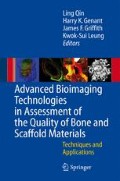Abstract
The assessment of changes in bone mineral density (BMD) requires follow-up measurements. In order to compute accurate changes, it is important that the region of interest (ROI) of the initial and follow-up measurements match in terms of location. Our present focus is the evaluation of bone at the distal end of the radius by peripheral quantitative computed tomography (pQCT). In adults, in whom the bones have ceased to grow, repositioning of the ROI has been attempted either by matching the measurement location defined as a fixed percentage of the bone length away from an anatomical landmark or by matching the cross-sectional areas of the bone in the conic distal region of the radius; however, in the case of children, whose bones are growing, these methods cannot be applied blindly. The aim of this study was to propose a model that aids in the relocation of the ROI during follow-up measurements in children.
From a long-term research study of multiple generations of volunteers, we were able to obtain sets of radiographs of forearms taken regularly from birth until the age of 18 years. From the radiographs of each subject, the bone lengths and widths were measured. The shapes of the bones were analyzed, and a model that predicts change in width based on change in length was developed. This model was modified to predict change in cross-sectional area based on change in length, assuming a cross-sectional geometry derived from a set of pQCT images over the same age range. It was observed that the shape of the radiographically projected radius between distal and proximal growth plates for a given subject did not vary with age. The model was tested by matching pairs of pQCT scans based on the cross-sectional areas predicted by the model. The pairs of images were compared qualitatively for a match in shape of the cross-section of the bone. If the cross-sectional shape matched closely, the two sections were considered to belong to the same region. From 26 evaluated pairs of cross-sections, 21 pairs had matching shapes. From this study we concluded that the proposed model produced satisfactory results in 81% of the tested cases. The failures were observed mostly at an age when the increase in length ceased but the increase in cross-section continued. The results of the qualitative evaluation is deemed encouraging and warrants further tests to see if ROIs defined with this model provide clinically meaningful results.
Access this chapter
Tax calculation will be finalised at checkout
Purchases are for personal use only
Preview
Unable to display preview. Download preview PDF.
References
Bilezikian JP, Raisz LG, Rodan GA (2002) Principles of bone biology. Academic Press, San Diego
Cootes T, Hill A, Taylor C, Haslam J (1994) The use of active shape models for locating structures in medical images. Image Vision Comput 12:355–366
Glüer M, Minne H, Glüer C, Lazarescu A, Pfeifer M, Perschel F, Fitzner R, Pollähne W, Scholt-thauer T, Pospeschill M (2005) Prospective identification of postmenopausal osteoporotic women at high vertebral fracture risk by radiography, bone densitometry, quantitative ultrasound, and laboratory findings: results from the PIOS study. J Clin Densitom 8:386–395
Grampp S, Lang P, Jergas M, Glüer CC, Mathur A, Engelke K, Genant HK (1995) Assessment of the skeletal status by peripheral quantitative computed tomography of the forearm: short-term precision in vivo and comparison to dual X-ray absorptiometry. J Bone Miner Res 10:1566–1576
Hangartner TN, Overton TR (1982) Quantitative measurement of bone density using gamma-ray computed tomography. J Comput Assist Tomogr 6:1156–1162
Harris S, Watts N, Genant H, McKeever C, Hangartner T, Keller M, Chestnut III C, Brown J, Eriksen E, Hoseyni M, Axelrod D, Miller P (1999) Effects of risedronate treatment on vertebral and nonvertebral fractures in women with postmenopausal osteoporosis: a randomized controlled trial. J Am Med Assoc 282:1344–1352
Lovell W, Morrissy B, Winter R, Morrissy R, Weinstein S (2001) Lovell and Winter’s pediatric orthopaedics. Lippincott Williams and Wilkins, Philadelphia
Pritchett J (1991) Growth plate activity in the upper extremity. Clin Orthop Rel Res 268:235–242
Rauch F, Tutlewski B, Fricke O, Rieger-Wettengl G, Schauseil-Zipf U, Herkenrath P, Neu CM, Schönau E (2001) Analysis of cancellous bone turnover by multiple slice analysis at distal radius: a study using peripheral quantitative computed tomography. J Clin Densitom 4:257–262
WHO study group (1994) Assessment of fracture risk and its application to screening for postmenopausal osteoporosis. World Health Organization, Geneva
Author information
Authors and Affiliations
Corresponding author
Editor information
Editors and Affiliations
Rights and permissions
Copyright information
© 2007 Springer-Verlag Berlin Heidelberg
About this chapter
Cite this chapter
Hangartner, T.N., Goradia, D., Short, D.F. (2007). Repositioning of the Region of Interest in the Radius of the Growing Child in Follow-up Measurements by pQCT. In: Qin, L., Genant, H.K., Griffith, J.F., Leung, K.S. (eds) Advanced Bioimaging Technologies in Assessment of the Quality of Bone and Scaffold Materials. Springer, Berlin, Heidelberg. https://doi.org/10.1007/978-3-540-45456-4_6
Download citation
DOI: https://doi.org/10.1007/978-3-540-45456-4_6
Publisher Name: Springer, Berlin, Heidelberg
Print ISBN: 978-3-540-45454-0
Online ISBN: 978-3-540-45456-4
eBook Packages: MedicineMedicine (R0)

